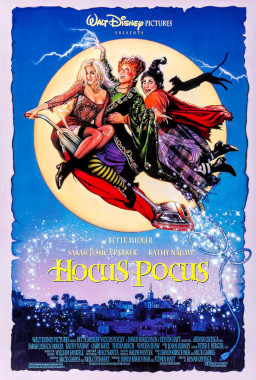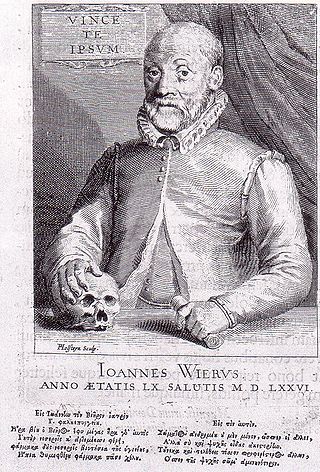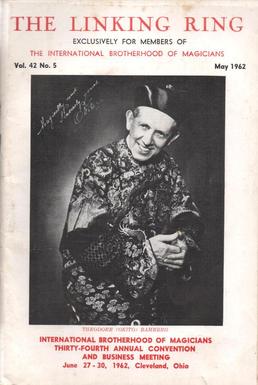Related Research Articles
Belief in magic exists in all societies, regardless of whether they have organized religious hierarchy including formal clergy or more informal systems. While such concepts appear more frequently in cultures based in polytheism, animism, or shamanism. Religion and magic became conceptually separated in the West where the distinction arose between supernatural events sanctioned by approved religious doctrine versus magic rooted in other religious sources. With the rise of Christianity this became characterised with the contrast between divine miracles versus folk religion, superstition, or occult speculation.

The cups and balls is a performance of magic with innumerable adaptations. Street gambling variations performed by conmen were known as Bunco Booths. A typical cups and balls routine includes many of the most fundamental effects of magic: the balls can vanish, appear, transpose, reappear and transform. Basic skills, such as misdirection, manual dexterity, sleight of hand, and audience management are also essential to most cups and balls routines. As a result, mastery of the cups and balls is considered by many as the litmus test of a magician's skill with gimmick style tricks. Magician John Mulholland wrote that Harry Houdini had expressed the opinion that no one could be considered an accomplished magician until he had mastered the cups and balls. Professor Hoffman called the cups and balls "the groundwork of all legerdemain".
Hocus-pocus is a reference to the actions of magicians, often as the stereotypical magic words spoken when bringing about some sort of change. It was once a common term for a magician, juggler, or other similar entertainers. In extended usage, the term is often used (pejoratively) to describe irrational human activities that appear to depend on magic. Examples are given below.
A trick deck is a deck of playing cards that has been altered in some way to allow magicians to perform certain card tricks where sleight of hand would be too difficult or impractical.

Reginald Scot was an Englishman and Member of Parliament, the author of The Discoverie of Witchcraft, which was published in 1584. It was written against the belief in witches, to show that witchcraft did not exist. Part of its content exposes how feats of magic were done, and the book is often deemed the first textbook on conjuring.

Hocus Pocus is a 1993 American fantasy comedy film directed by Kenny Ortega from a screenplay by Mick Garris and Neil Cuthbert, and a story by David Kirschner and Garris. It follows a villainous comedic trio of witches who are inadvertently resurrected by a teenage boy in Salem, Massachusetts, on Halloween night.

Street magic falls into two genres; traditional street performance and guerrilla magic.
This timeline of magic is a history of the performing art of illusion from B.C. to the present.

De praestigiis daemonum, translated as On the Tricks of Demons, is a book by medical doctor Johann Weyer, also known as Wier, first published in Basel in 1563. The book argues that witchcraft does not exist and that those who claim to practice it are suffering from delusions, which should be treated as mental illnesses, rather than punished as witchcraft. It was influential in the abolishment of witchcraft trials in the Netherlands.

"Hocus Pocus" is a song by the Dutch rock band Focus, written by keyboardist, flutist, and vocalist Thijs van Leer and guitarist Jan Akkerman. It was recorded and released in 1971 as the opening track of their second studio album Moving Waves. An edited version was released as a single on the Imperial, Polydor and Blue Horizon labels in Europe in 1971, but failed to chart outside of the Netherlands(NL#09).

Joshua Jay is an American magician, author, and lecturer. He has performed in over 100 countries and was awarded top prize at the World Magic Seminar in 1998. He worked with Penn and Teller on the show Fool Us, and he holds a Guinness World Record for card tricks. Jay has performed on shows including Good Morning America and The Today Show. In January 2018, Jay was recognized by the Society of American Magicians for his contribution to the art of magic.
Upsy Downsy is a brand developed by Mattel. It concerns two races of strange beings, one that lives rightside-up, the other upside-down. These psychedelic creatures and their fantasy world were featured in a short-lived line of colorful toys and story books for young children in 1970.
The Guillotine is a magic trick where it appears that a blade of a guillotine passes through a person's neck without harming them. Variations on the theme have been performed for hundreds of years, with documented examples appearing in print in the 16th century. The most common modern variation is the finger guillotine or finger chopper, a pocked-sized version that appears to chop off the magician's finger.

Thomas Ady was an English physician and humanist who was the author of two sceptical books on witchcraft and witch-hunting.

The Linking Ring is a monthly print magic magazine published by the International Brotherhood of Magicians (IBM) for its members since 1922. It is based in Bluffton, Ohio. In 2007, Samuel Patrick Smith, a magician, author and publisher based in Eustis, Florida, became executive editor of the magazine.

The Discoverie of Witchcraft is a book published by the English gentleman Reginald Scot in 1584, intended as an exposé of early modern witchcraft. It contains a small section intended to show how the public was fooled by charlatans, which is considered the first published material on illusionary or stage magic.

Magic, which encompasses the subgenres of illusion, stage magic, and close-up magic, among others, is a performing art in which audiences are entertained by tricks, effects, or illusions of seemingly impossible feats, using natural means. It is to be distinguished from paranormal magic which are effects claimed to be created through supernatural means. It is one of the oldest performing arts in the world.
The book test is a classic mentalism demonstration used by mentalists to demonstrate telepathy-like effects. The name refers to its early use as a test of mental powers.
The Inexhaustible Bottle is a classic magic trick performed by stage magicians. It dates to the 17th century and has since inspired many variations; well known examples include Any Drink Called For, The Bar Act, Satan's Barman, the Assassin's Teapot and Think-a-Drink. During the temperance movement it became The Obliging Tea Kettle, and the modern Magic Tea Kettle remains a common prop available at most magic stores. A slight variation is the Magic Funnel. Today, the trick is normally performed for children, although some stand-up shows retain a variation.

Hocus Pocus 2 is a 2022 American fantasy comedy film directed by Anne Fletcher, written by Jen D'Angelo and produced by Walt Disney Pictures. It is a sequel to the 1993 film Hocus Pocus and the second installment in the Hocus Pocus franchise. The film stars Bette Midler, Sarah Jessica Parker, Kathy Najimy, and Doug Jones reprising their roles, with Sam Richardson, Whitney Peak, Belissa Escobedo, Tony Hale, and Hannah Waddingham joining the cast in new roles.
References
Citations
- ↑ Jay 2014, p. 9.
- 1 2 Buchan 2013, p. 61.
- ↑ Scot, Reginald (1584). The Discoverie of Witchcraft. Clements Library.
- ↑ Almond, Philip (2011). England's First Demonologist: Reginald Scot and 'The Discoverie of Witchcraft'. I.B.Tauris. Archived from the original on August 26, 2014.
- ↑ Scot 1584, p. 283.
- 1 2 3 4 Stafford & Terpak 2001, p. 253.
- ↑ Jay 2014, p. 10.
- 1 2 3 Anonymous 1635, Iugling booke.
- ↑ Jay 2014, p. 15.
- ↑ Jay 2014, p. 12.
- ↑ The Print Collector's Newsletter, 1995, p. 107.
- 1 2 Kaufman 2010, pp. 220–223.
- ↑ The Wiggles - Magic: Coloring Book
Bibliography
- Anonymous (1635). Hocus Pocus Junior: The Anatomie of Legerdemain.
- Buchan, Suzanne (2013). Pervasive Animation. Routledge.
- Jay, Ricky (2 April 2014). LIVE from the New York Public Library.
- Kaufman, Richard (2010). Knack Magic Tricks. Globe Pequot.
- Scot, Reginald (1886). The discoverie of witchcraft. Elliot Stock.
- Stafford, Barbara Maria; Terpak, Frances (2001). Devices of Wonder: From the World in a Box to Images on a Screen. Getty Publications.